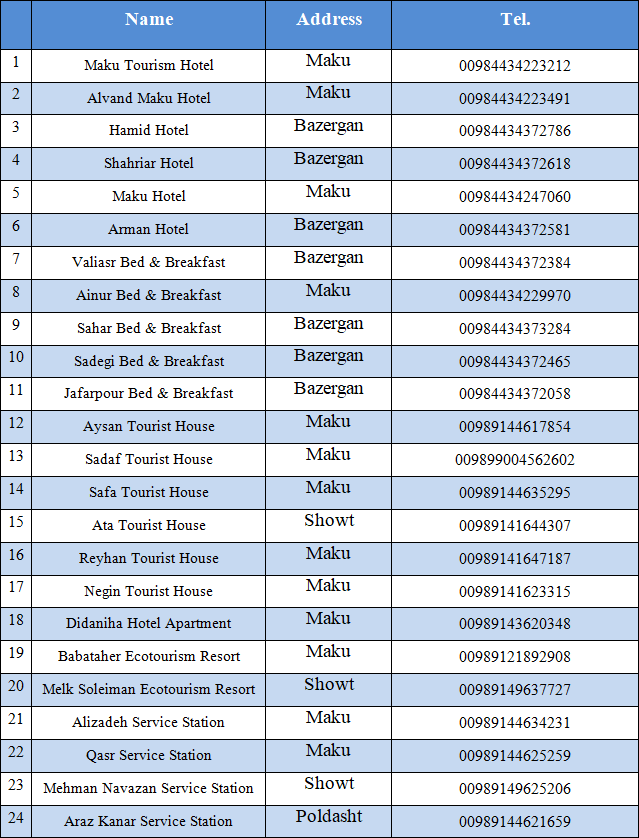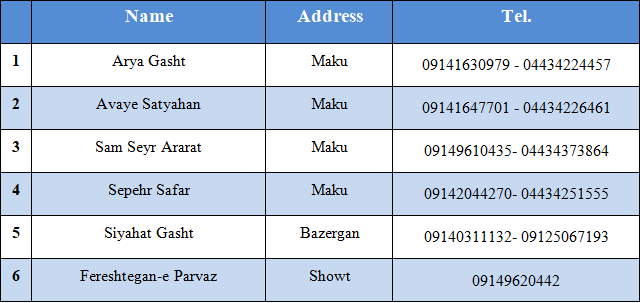Tourism
Centers and Infrastructure
- Baghcheh Joogh Palace
The Baghcheh Joogh Palace Museum is located two kilometers from Maku-Bazargan road in the village of Baghcheh Joogh. This palace was built in 1893 by the order of Iqbal-al-Saltanah Makuyi (one of the commanders of Mozaffar al-din Shah). Baghcheh Joogh Palace is a two-story building with a gabled roof in the middle of an 11-hectare garden, which has created an eye catching scene. In terms of applied materials and the type of doors and windows, it has its own style, which in addition to Iranian architecture, the influence of Western architecture is clearly evident. The paintings in the building, which have been drawn with great care and elegance on the interior of the ground and first floors, demonstrate the taste of the skilled craftsmen.
- Maku Pergola( Kolah Farangi) Mansion
The pergola building is located on Taleghani Street in Maku and is part of a large complex belonging to Ali Qoli Khan Bayat Maku during the Qajar period and is like a jewel in the middle of Maku. This mansion is built on two floors with a gable roof and a regular octagonal design and has decorations, mirror work and paintings. The interior patterns of this building are in the shape of a cross; and have a balcony with twenty columns around itself.
- “Shir-o- Khorshid” Mansion
“Shir-o- Khorshid” building is located on Taleghani Street, next to the Pergola mansion, and belongs to a member of the Bayat Makoei family during the Qajar period. This building is also referred to as the Judicial Council of the City. This building has two floors and has beautiful wooden windows and plastering on the columns and facade of the building.
- Melli Bank Building
This building belongs to Ahmad Khan Bayat Mako known as Afkham Al-Saltanah and was designed and built in the Qajar period in the middle of a large garden of about 2.5 hectares. It has been built on two floors with a rectangular plan and has been the residence of above mentioned family. Later, it was turned into an army hospital and continued for several years. After Maku was occupied by the Russians, it was used as a consulate. During the time of Prime Minister (Ghavam Al-Saltanah) when the Russians returned to their country, this building was used as Melli Bank of Maku branch and had continued until 1352.
- Shahrebani (Police) Building
This building is located on Imam Khomeini Street in Maku city and was built by one of Maku Khans, which was later purchased by the former police. The date of construction of this building is unknown. But according to the inscription in the Hall of Mirrors, its construction date is 1902. The old Maku police building is built on two floors. The first floor lacks decorations and large spaces. But on the second floor, in terms of general design, plan and lighting, reasonable divisions and architectural proportions, the presence of a mirror hall and large doors in the mirror hall and adjacent rooms with stained glass and plaster decorations of the exterior facade, including decorates, sculptures, shapes of flowers and plants, etc., have given great value to this building. The plan of the building almost induces the building form of the Bghcheh Joog Palace.
- “Darayee” Building
“Darayee” Building belongs to the Qajar period and has been constructed in a garden-like space with dimensions of 80 to 50 in a rectangular shape on two floors and in a completely symmetrical shape. This building is located on the northwest side of Imam Street and, like other historical buildings in Maku, is built on a stone platform. The building is formed as a strip in the east-west direction and has two short protrusions of 2.7 meters on both sides of the northern part form the main entrances to the upper floor. The difference between the level of the north and south areas is 3.1 meters and the building is established on three levels.
- Qaban Castle
On the northwest side of the city of Maku, there is a rock with a very amazing and spectacular depression and protrusion, which is locally called Ghayeh. This unique rock, like a canopy, covers a large part, under which, historical monuments which is called a castle, lie. This castle is also surrounded by eye-catching and strong towers and fortifications that boost the strength and grandeur of the castle. Qaban Castle is one of the fascinating historical monuments of Maku and is located in the oldest part of Maku under a concave cliff overlooking this city. This area is the most beautiful and at the same time the scariest place that man can live. In the past, Qaban Castle was the main part of the city, which was located under a large stone cap with fences, tall towers and fortifications, military barracks and residential and service centers, and was inhabited during the Timurid, Safavid, Qajar and contemporary eras.
- Eyvan-e Farhad (Farhad Roof)
It is located 7 km out of Maku, next to Maku-Bazargan road in Sangar village. This monument was built next to a historical fortress from the Urartu period and belongs to the seventh century BC. It includes a carved stone staircase connecting three rooms with outside. Adjacent to it and by the river is the altar of this ancient city.
- Zor Zor Church
Zor Zor Church is located 20 km from Maku, in the village of Baroon. This church consists of two old churches belonging to the seventh century and another church belonging to the 14th century, which was built on the old church. The building of this church was moved to a higher place, 600 meters from the main site, in 1988, due to the flooding of the Baroon Dam, with the preservation of architectural documents and the existing materials. Zor Zor Church is the only registered work of Maku Free Zone in the UNESCO World Heritage List.
- Beshgoz Bridge (Five Springs)
Beshgoz Bridge is located about one kilometer from Maku city. According to available sources, this bridge dates back to Safavid times. The overall dimensions are 51 meters length and 3.5 meters width. The length of the mouth of the big span is 7 meters and the smallest span is 4.5 meters and the thickness of the columns is 2 meters. In the construction of the bridge, clean cut stones have been used at the edges as well as the cover, and irregular stones have also been used to cover the surfaces.
- Gal-eh Joogh Bridge
This bridge is 10 meters long and 4.5 meters wide next to Qal-eh Joogh village and has been constructed to connect Qal-eh Joogh to Maku. Qala-eh Joogh Bridge consists of a large span and a small span, and the materials used in this bridge, like the Beshgooz Bridge in Maku, are made of stone and plaster. This bridge has no foundation due to its location on the rocky floor of the river, and in fact, the foundation of the bridge is based on a rocky floor.
- Keshmesh Tappeh Bridge
This bridge is located in Maku, near the village of Keshmesh Tappeh. The architecture of the Keshmesh Tappeh Bridge indicates that this work is related to the late Qajar and early Pahlavi periods. The bridge has three spans with low arches. Stone materials at the base of the bridge and bricks on the cover were used. The foundations of this bridge have curved breakers on both sides. In this bridge, black and white stones have been used to create decorations and these decorations have been placed along the bases of the bridge in the shape of a rhombus with white stones in the middle of the black frame and also black stones have been used at the edges of the arches.
- Maku Rocky Cliff
This huge stone cliff, approximately 7 km long, surrounds the city of Maku on the north side and has created a scary but very beautiful scene. The rocky cliff of Maku is one of the largest curved rocks in the world with an adverse gradient of 40 degrees, called Ghayeh, which is like an umbrella over the city of Maku. One of the historical inscriptions of Iran has been carved by the order of Shah Abbas Safavid on this huge rock.
- Rock Climbing in Maku Free Zone
Apart from its ancient and glorious history, Maku Free Zone has a unique feature that distinguishes it from other free zones in Iran, which is its rocky nature. Maku Free Zone has good attractions for rock climbers due to its huge steep cliffs (Cherkin mountains, Sabad Daghi, Qayeh, etc.) and is a very ideal place for regional, national and international rock tours and festivals.
- Recreational and Flying Sports (Paragliding) in Maku Free Zone
Maku Free Zone, due to its high altitudes, has a special potential for flying sports. Adventurous sports pros consider Maku Mountains a paradise for paragliding and other flying sports. Flying sites in Maku Free Zone in Qarah Khach tourism hub are located geographically so that access to paragliding take-off and landing area is in a short distance.
- Cheshmeh Sorayya
Cheshmeh Sorayya is a large and spectacular spring located in the northernmost geographical point of Iran on the border of Iran and Turkey. Adjacency to the snow-capped mountains of Ararat in Turkey and the presence of numerous nomads and villages with different cultures and customs along the route of this spring, have converted this place to one of the eco-tourism hubs of Maku Free Zone.
- Su Daresi (Rend Valley)
Su Daresi, better known as the Rend Valley, is located north of Maku, along the village of Rend. The presence of a river full of water and vast fields and rocks has turned this place into a beautiful promenade with a pleasant climate.
- Basaltic Prisms
Maku Basaltic Prisms is located 25 km from Maku on Maku-Chaldoran road and is unique in the world because it was emerged as a result of the freezing of volcanic lava in the third geological period. In this zone, due to lava freezing shrinkage and tensile force in three directions parallel to the lava surface and igneous mass in the vertical direction has formed straight hexagonal columns.
- Showt Spa
Showt hot spring is located in a pleasant environment on the outskirts of Showt. It has two main springs, which are located at a 40 meters distance on a mound with different heights. The main manifestation of the spring is a natural pond in an irregular shape, which has created natural and interesting ponds due to the water deposition, and pools have been built on the ponds.
- Aras Dam Lake
This lake, behind the Aras Dam, is located on the border of the Islamic Republic of Iran and the Republic of Nakhchivan. It is one of the lake shores in northwestern Iran. Aras Dam Lake is a home for migratory birds that migrate from northern Europe and Siberia in autumn and winter. Aras Camp promenade is located next to this lake.
- Boralan Wetland
The valuable Boralan wetland is located in the Ararat Mountains region on the Iranian-Turkish border. This border wetland originates from the joint border of Iran and Turkey on the south of Qarasu River north of Dem Gheshlagh village and extends along the border of Iran and Turkey to the area called Cheshmeh Sorayya which is the origin of Qarasu River. This wetland is home to various types of aquatic and coastal species and is one of the most beautiful natural attractions in the region that can be visited by nature lovers.
- Yarim Qayeh Wetland
This border wetland is a vast reed between the two countries of Iran and Turkey, with an area of about 400 hectares. The distance from Maku is 23 km and from Bazargan is about 3 km. This wetland has rich vegetation. This wetland has rich vegetation and due to its location certain birds live in this habitat. Most of these birds are cranes that breed in this area and this can be the biggest factor of natural attraction.
- Qaleh Joogh Waterfall
Qaleh Joogh waterfall is located five kilometers southwest of Maku, on the outskirts of Qaleh Joogh village and in the middle of the beautiful Qaleh Jogh Mountains. The height of this waterfall is about 80 meters, and its location is very beautiful and easily accessible and its atmosphere remains completely pristine.
- Bashkand Spa
Located 6 km from Bazargan road, Baskand Spa springs out of the ground on the road of Kelisakandi. Its rocks are calcareous and water comes out in several places along with gas. The water of this spring is used for bathing and as a pain relief.
- Baroon Maku Dam
Baroon Dam is built on Zangmar River near Baroon village; and is one of the largest dams in Maku, which has beautiful scenery as well as a large lake conducive for fishing. Thanks to its location next to Zor Zor Church, Baroon Dam is visited by many tourists.
- Protected Area of Agh Gol
Located in the northeast of Maku, this region has an area of about 90,000 hectares and its highest point is 2362 meters above sea level. Agh Gol region, due to its natural conditions, suitable vegetation and good life conditions, has long been the habitat of various species of wildlife, and in recent years, in order to revive extinct wildlife, a number of wild rams and ewes from Kaboudan Island in Urmia Lake were transported to this area.
- Maku International Airport
Maku Free Zone is considered as the youngest and at the same time the largest free zone in the country, which is far from major metropolitans such as Tehran, Tabriz, Urmia. Development of economic infrastructure has been one of the main factors in establishment of an airport in this region and is the third airport in West Azerbaijan Province, located in Maku Free Trade-Industrial Zone. The construction of this airport began in June 2014 on a land with an area of about 400 hectares. The flight area is 200 hectares and its runway length is 3,270 meters. The airport is designed for Airbus 320 aircraft and has 8,000 square meters of main terminal and 800 square meters of ceremonial hall, and the height of the watchtower is 33 meters. The operation of this airport, which officially began on May 2017, is one of the most important infrastructure measures in the region with the aim of facilitating trade and development in the northwestern point of the country and near the European Gate. There are now three round-trip flights a week from Tehran and vice versa.
- Accommodation Units of Maku Free Zone:

- Maku Free Zone Travel Services Centers


